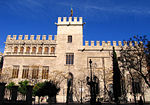Valencian Museum of Ethnology

The Valencian Museum of Ethnology (Museu Valencià d'Etnologia) is a museum located in the city of Valencia, mediterranean Spain. The museum mission defines it as cultural institution primarily devoted to collect, research and communicate the tangible and intangible heritage related to traditional and popular Valencian culture. The mission underlines that the museum also aims to permanently question fundamental aspects of the culture, as the dynamics that built it and force it to evolve, as well as its diversity. Although fundamentally devoted to Valencian cultural identity within a Mediterranean context, this museum also works to give visitors the chance to understand the challenges and dynamics of culture as a whole and from a contemporary perspective.
Excerpt from the Wikipedia article Valencian Museum of Ethnology (License: CC BY-SA 3.0, Authors, Images).Valencian Museum of Ethnology
Carrer de la Corona, Valencia Ciutat Vella
Geographical coordinates (GPS) Address Phone number Website Nearby Places Show on map
Geographical coordinates (GPS)
| Latitude | Longitude |
|---|---|
| N 39.478422222222 ° | E -0.38312777777778 ° |
Address
Centre Cultural la Beneficiència (Centre Museístic la Beneficiència)
Carrer de la Corona 36
46003 Valencia, Ciutat Vella
Valencian Community, Spain
Open on Google Maps











